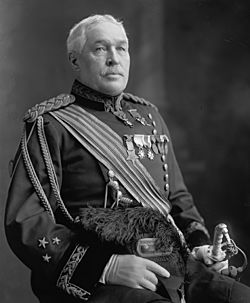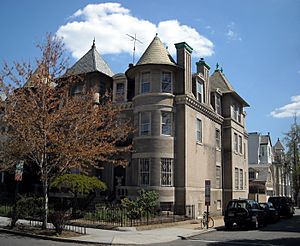Samuel Baldwin Marks Young facts for kids
Quick facts for kids
Samuel Baldwin Marks Young
|
|
|---|---|
 |
|
| Born | January 9, 1840 Pittsburgh, Pennsylvania, US |
| Died | September 1, 1924 (aged 84) Helena, Montana, US |
| Buried | |
| Allegiance | Union United States |
| Service/ |
Union Army United States Army |
| Years of service | 1861–1865 1866–1904 |
| Rank | Lieutenant General |
| Commands held | Chief of Staff of the United States Army |
| Battles/wars | American Civil War Indian Wars Spanish–American War Philippine–American War |
Samuel Baldwin Marks Young (born January 9, 1840, died September 1, 1924) was an important general in the United States Army. He was the very first president of the United States Army War College from 1902 to 1903. After that, he became the first Chief of Staff of the United States Army, serving from 1903 to 1904.
Contents
Early Life and Military Beginnings
Samuel Young was born in Pittsburgh, Pennsylvania. His parents were John Young Jr. and Hannah Scott Young. He went to Jefferson College, which is now called Washington & Jefferson College. In 1861, he married Margaret McFadden.
Joining the Civil War
When the American Civil War started in April 1861, Samuel Young joined the 12th Pennsylvania Infantry. He started as a private, which is the lowest rank. After his first term, he became a captain in the 4th Pennsylvania Cavalry in September 1861.
He served bravely with the Army of the Potomac throughout the war. He was promoted several times:
Young was injured four times in 1864 and 1865. He led a group of cavalry during the final days of the Appomattox Campaign. He left the volunteer army on July 1, 1865.
After the Civil War
After the war, Young joined the Military Order of the Loyal Legion of the United States. This was a group for officers who fought for the Union in the Civil War. He was also a member of the Society of the Army of the Potomac.
Service in the Regular Army
In May 1866, Samuel Young rejoined the Regular Army as a first lieutenant. He was promoted to captain of the 8th Cavalry in July 1866.
On December 11, 1866, President Andrew Johnson suggested that Young be given the special rank of brigadier general of volunteers. This was to honor his service in the Siege of Petersburg and the Appomattox Campaign. The U.S. Senate approved this on February 6, 1867.
Fighting in the Indian Wars
Young continued to serve with honor during the Indian Wars. He was promoted regularly:
The Spanish-American War
When the war with Spain began in May 1898, Young was promoted to brigadier general of volunteers. In Cuba, he commanded one of two cavalry brigades. These brigades were part of the Cavalry Division led by Major General Joseph Wheeler. Young's brigade included Theodore Roosevelt's famous Rough Riders.
After the American victory at the Battle of San Juan Hill in July 1898, Young took command of Wheeler's Cavalry Division. He was made major general of volunteers while leading this division in Cuba during the Spanish–American War. That same year, Young became a Veteran Companion of the Missouri Commandery of the Military Order of Foreign Wars.

The Philippine-American War
During the Philippine–American War, he returned to the rank of brigadier general of volunteers. He led brigades in the Northern Luzon District and was made its military governor.
From February 1901 to March 1902, he commanded the military district of California from the Presidio of San Francisco. In August 1903, he was chosen to be the first chief of staff of the General Staff. He held this important position until he retired in January 1904.
Later Life and Legacy
From 1909 to 1910, Samuel Young was the president of a special board. This board looked into an event involving black soldiers of the 25th U.S. Infantry in Brownsville, Texas in 1906. The board confirmed that 159 soldiers were dishonorably discharged by order of President Theodore Roosevelt.
Protecting National Parks
In 1897, Colonel Young served as the Acting Superintendent of Yellowstone National Park at Fort Yellowstone. Before that, he had a similar role at Yosemite in 1896. While at Yellowstone, he started important rules to protect fish. After he retired in 1907, he was appointed full Superintendent of Yellowstone by the Secretary of the Interior. He served in this role for two years.
Samuel Young passed away at his home in Helena, Montana. He was honored with a state funeral in Washington, D.C., and was buried in Arlington National Cemetery.
Family Life
Samuel and Margaret Young had seven children: six daughters and one son. Their children were Edith (1865–1940), Burton (also called Hannah) (1866–1944), Lillian (1868–1956), Marjorie (1872–1956), Eliza (1880–1883), Ranald Mackenzie (1880–1882), and Elizabeth (1883–1966).
- In 1886, his daughter Burton (Hannah) married George Windle Read. George Read became a major general and led divisions in the American Expeditionary Force during World War I. Their children included Burton Young Read, who became a colonel, and George Windle Read, Jr., who became a lieutenant general.
- In 1886, his daughter Edith married army officer John Thornton Knight. Their son, John Thornton Knight, Jr., received a special award for bravery during World War I.
- In 1901, his daughter Marjorie married army surgeon John Heysham Gibbon. John H. and Marjorie Gibbon were the parents of John Heysham Gibbon.
- In 1903, Young's daughter Elizabeth married Army officer John Robert Rigby Hannay.
- In 1913, his daughter Lillian, who was active in the Christian Science church, married Eugene R. Cox.
Awards and Recognition
Samuel Young received several medals for his service:
- Civil War Campaign Medal
- Indian Campaign Medal
- Spanish Campaign Medal
- Philippine Campaign Medal
Military Ranks Over Time
| Insignia | Rank | Date | Component |
|---|---|---|---|
| No insignia | Private | 25 April 1861 | Volunteers |
| Captain | 6 September 1861 | Volunteers | |
| Major | 20 September 1862 | Volunteers | |
| Lieutenant Colonel | 1 May 1864 | Volunteers | |
| Colonel | 25 June 1864 | Volunteers | |
| Brevet Brigadier General | 9 April 1865 | Volunteers | |
| First Lieutenant | 11 May 1866 | Regular Army | |
| Captain | 28 July 1866 | Regular Army | |
| Major | 2 April 1883 | Regular Army | |
| Lieutenant Colonel | 16 August 1892 | Regular Army | |
| Colonel | 19 June 1897 | Regular Army | |
| Brigadier General | 4 May 1898 | Volunteers | |
| Major General | 8 July 1898 | Volunteers | |
| Brigadier General | 2 January 1900 | Regular Army | |
| Major General | 2 February 1901 | Regular Army | |
| Lieutenant General | 8 August 1903 | Regular Army |

